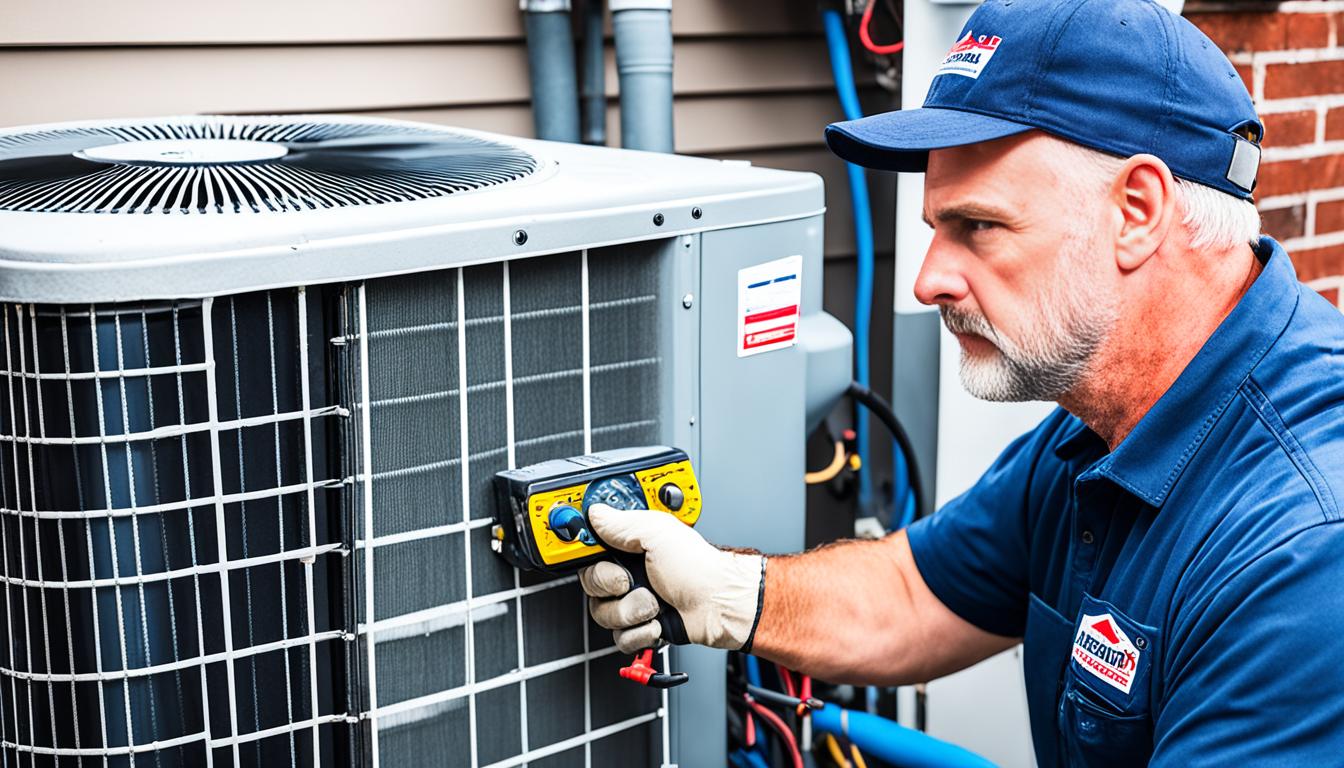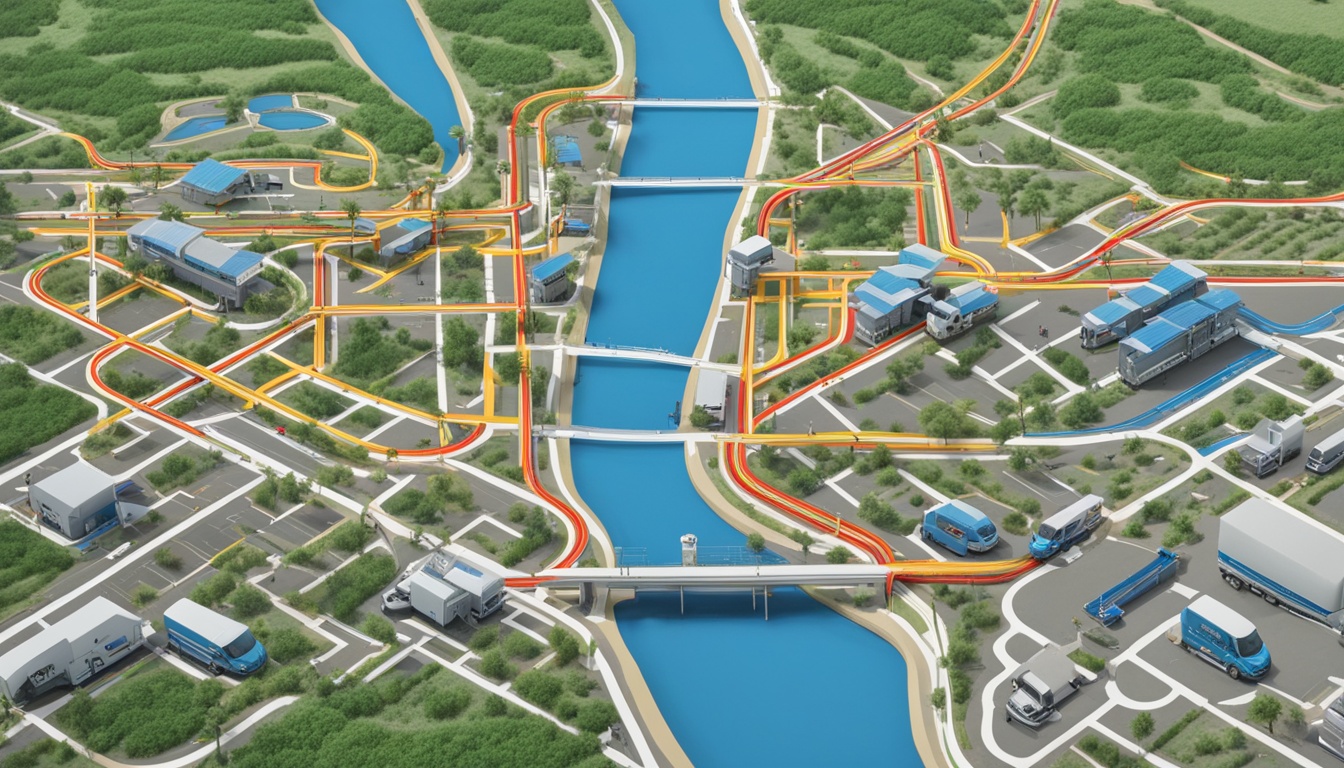Did you know companies using specialized tools for technician management save an average of 20 hours weekly on administrative tasks? This hidden time drain often stems from manual processes like dispatching, invoicing, and customer follow-ups. Automation isn’t just a buzzword—it’s reshaping how teams handle daily operations, turning chaos into streamlined workflows.
Modern field service platforms, like FieldEdge, act as a central hub for coordinating teams. They eliminate guesswork in assigning jobs by matching technician skills to specific needs. Real-time updates keep everyone aligned, reducing delays and missed appointments. The result? Happier customers and fewer headaches.
Adopting these tools isn’t about replacing human judgment. It’s about empowering teams to focus on growth instead of paperwork. For example, automated route planning cuts fuel costs, while integrated payment systems speed up cash flow. These small efficiencies add up, creating space to scale operations without burnout.
In this guide, we’ll explore how intuitive design and smart features work together. You’ll learn practical steps to implement systems that boost productivity and keep clients coming back. Let’s dive into the future of efficient field operations.

Key Takeaways
- Automation saves 20+ hours weekly by streamlining dispatching and billing tasks.
- Real-time communication reduces delays and improves customer transparency.
- Route optimization tools lower travel costs and technician downtime.
- Integrated CRM systems simplify client history tracking and follow-ups.
- Scalable solutions grow with your team, avoiding costly software swaps later.
Introduction to Automating HVAC Service Scheduling
Tech giants aren’t the only ones benefiting from automation. Small and mid-sized companies are now using smart tools to handle repetitive tasks like dispatching technicians or updating clients. This shift lets teams focus on what matters—delivering quality work without drowning in spreadsheets.
Why Automation is Essential for HVAC Businesses
Manual processes create bottlenecks. When dispatchers juggle calls and paper records, mistakes happen. Field service software solves this by auto-assigning jobs based on technician expertise and location. For instance, platforms like FieldEdge use map-based tools to slash drive times by up to 30%.
Clients expect instant updates. Automated systems send real-time alerts about arrival times or rescheduled appointments. This transparency builds trust and reduces no-shows. One contractor reported a 40% drop in missed visits after switching to digital workflows.
Overview of Field Service Software Benefits
These tools do more than organize calendars. They sync invoices with completed jobs, letting teams bill faster. Built-in CRM features track client preferences and service histories, so technicians arrive prepared.
Take route optimization. AI analyzes traffic patterns to suggest the fastest paths. This cuts fuel costs and lets crews handle more jobs daily. Plus, automated reminders keep customers informed without extra staff effort.
By reducing manual data entry, businesses reclaim hours for training or expanding services. It’s not just about working harder—it’s about working smarter.
Understanding HVAC Field Service Software
Imagine your team handling twice as many jobs without working overtime. Specialized tools for field operations turn this scenario into reality by tackling daily chaos head-on. These systems act as digital command centers, organizing everything from technician assignments to client billing in one place.
Key Features and Capabilities
Smart dispatching matches workers’ certifications to job requirements automatically. For example, a furnace repair gets routed to someone trained in gas systems. Work orders update instantly when technicians complete tasks, so managers see progress without phone tag.
Real-time GPS tracking helps teams adjust routes during traffic jams. One contractor cut drive times by 25% using this feature. Built-in reporting tools highlight patterns, like which jobs take longest, helping businesses refine their workflows.
How FieldEdge Elevates Operations
FieldEdge’s mobile app lets workers create invoices at the job site. Payments process before they leave the driveway—no more chasing checks. The platform’s live map shows all active assignments, so dispatchers reroute crews when emergencies pop up.
Its custom dashboard aggregates client histories and equipment details. A tech can review a home’s past maintenance while driving there. This prep work slashes repeat visits by 18% for some companies. Tools like these transform clunky processes into seamless routines.
Benefits of Automation for HVAC Businesses
What if your team could tackle 30% more jobs without hiring extra staff? Modern automation tools make this possible by transforming how companies manage daily tasks. Let’s explore how smart technology strengthens both productivity and profit margins.
Boosting Operational Efficiency
Automated dispatching eliminates guesswork by matching techs to jobs based on skill and location. One contractor reduced drive times by 25% using map-based routing. Real-time updates keep everyone aligned, cutting delays and last-minute scrambles.
Digital work orders update instantly when tasks wrap up. Managers see progress without chasing updates. This accuracy slashes repeat visits—some businesses report 18% fewer callbacks.
Reducing Costs and Saving Time
Platforms like FieldEdge save teams up to 20 weekly hours through smarter workflows. For example, automated route planning trims fuel costs by 15-30%. Instant invoicing and payments at job sites speed up cash flow—no more waiting for checks to clear.
Clients benefit too. Automated reminders cut missed appointments by 40% for many companies. Clear communication builds trust, leading to repeat business and referrals. When operations run smoothly, growth becomes sustainable rather than stressful.
How to Automate HVAC Service Scheduling Using Software
Transitioning to automated workflows doesn’t require a tech overhaul—just the right approach. Modern tools simplify complex processes, letting teams focus on delivering quality results. Here’s how to roll out these systems without disrupting daily operations.
Step-by-Step Implementation Process
Start with platform selection based on your team’s size and needs. FieldEdge’s demo showcases features like map-based dispatching and live job tracking. Cloud setups often go live in days, skipping bulky hardware installations.
Next, integrate the software with existing tools. Sync accounting programs and client databases to centralize information. Customizable digital forms replace paper work orders, cutting data entry errors by half for many businesses.
Training comes next. FieldEdge offers role-specific guides for dispatchers and technicians. Mobile apps let crews update job statuses onsite and process payments instantly. Most teams master the system in under three weeks.
Finally, monitor performance through built-in dashboards. Track metrics like average response times or completed work orders. Adjust routing rules or notification preferences as your workflow evolves.
Full implementation typically takes 6-8 weeks. Early adopters report 35% fewer missed appointments and faster invoice processing. With clear communication and phased rollouts, automation becomes a natural extension of your team’s expertise.
Essential Features in HVAC Management Software
The backbone of any efficient operation lies in its tools. Modern platforms combine multiple functions into unified systems, eliminating the chaos of juggling separate apps. Let’s break down the core components that keep teams productive and clients satisfied.
Scheduling, Dispatching, and Work Order Management
Map-based dispatching assigns jobs by technician proximity and expertise. Imagine a system that automatically sends furnace repairs to certified specialists within a 10-mile radius. FieldEdge’s live tracking updates routes during traffic delays, cutting drive times by 19% for many teams.
Digital work orders replace paper forms, reducing errors and duplicate entries. Crews update task statuses onsite, syncing data instantly with office dashboards. Custom templates let managers create job checklists in seconds—no more hunting for clipboards.
Service Agreements and Customer Information Tracking
Automated reminders for maintenance contracts ensure recurring revenue streams. One provider saw a 27% uptick in renewals after implementing this feature. Centralized profiles store equipment details and past interactions, so technicians arrive knowing the home’s history.
Integrated CRMs sync invoices with client portals, allowing same-day payments. For example, platforms like Jobber let customers approve quotes digitally, speeding up project starts. All documents stay organized in cloud storage, accessible from any device.
These features transform scattered processes into cohesive workflows. When every tool works together, businesses save time while delivering consistent, high-quality results.
The Role of Mobile Apps in HVAC Service Scheduling
Today’s mobile tools do more than just track locations—they redefine teamwork. FieldEdge’s app acts like a digital foreman, keeping crews connected and clients informed. Workers access job details, customer histories, and traffic alerts from their phones, turning chaotic days into organized workflows.
Powering Smarter Field Decisions
Real-time updates eliminate radio silence between offices and trucks. Dispatchers adjust assignments instantly when emergencies pop up, sending alerts directly to techs’ devices. One crew reported handling 22% more daily calls after adopting this feature.
Map-based routing uses live GPS data to plot efficient paths. FieldEdge’s color-coded maps show nearby jobs, helping teams prioritize stops. This cut drive times by 19% for a Chicago contractor last quarter.
Customers get automatic texts when crews are en route or delayed. Techs attach before/after photos to digital invoices, speeding up approvals. One homeowner said, “Knowing exactly when they’d arrive removed all the guesswork.”
Managers track progress through dashboards showing active jobs and ETAs. Skill-based filters ensure the right person handles each task. When a water heater repair required special certification, the software auto-assigned it to a qualified specialist eight minutes away.
These tools turn phones into pocket-sized command centers. Teams spend less time deciphering paper maps or playing phone tag—more time delivering results that keep clients loyal.
Choosing the Best HVAC Business Software
Picking the right tools for your team is like choosing a reliable truck—it needs to handle rough roads while keeping everyone on schedule. Look for platforms that grow with your company. Scalability matters whether you’re a local crew or a multi-state operation.
Start by testing how easily the software integrates with your current tools. Can it sync with accounting programs or customer databases? FieldEdge, for example, adapts to both small teams and large enterprises with customizable dashboards. Their configurable plans let you pay only for what you need.
Prioritize features that save time daily. Map-based dispatching and mobile invoicing cut paperwork, while CRM tools track client histories automatically. One user reported 30% faster billing after switching to a system with built-in payment processing.
Transparent pricing models prevent surprise fees. Many providers offer free demos—use these to compare options hands-on. FieldEdge’s trial lets you test live job tracking and skill-based dispatching before committing.
Remember, the best choice boosts efficiency and customer satisfaction. Teams using tailored solutions see fewer errors and happier clients. Ready to explore? Schedule a demo today to find your perfect match.
Maximizing Customer Satisfaction with Field Service Solutions
Customer loyalty thrives on clear communication and reliability. Modern tools bridge gaps between teams and clients, turning routine appointments into trust-building moments. Let’s explore how smarter interactions create lasting relationships.
Enhanced Communication and Appointment Reminders
Automated reminders eliminate confusion by sending alerts via text or email. FieldEdge’s system notifies clients 24 hours before visits, cutting missed appointments by 33% for many businesses. Customers appreciate knowing exactly when to expect technicians.
Real-time updates keep everyone informed. If traffic delays a crew, the software sends revised ETAs instantly. One family praised this feature after receiving three updates during a stormy repair day—no more guessing games.
Centralized customer profiles store service histories and equipment details. Technicians review past work en route, avoiding repetitive questions. A homeowner remarked, “They already knew about my furnace issue—it felt personalized.”
Streamlined dispatching ensures the right specialist handles each job. FieldEdge’s CRM flags clients with ongoing maintenance plans, triggering automatic follow-ups. This proactive approach boosts renewal rates by 28% for some providers.
Digital invoicing completes the experience. Payments process onsite through secure mobile apps, with receipts emailed instantly. Faster transactions mean happier customers and healthier cash flow.
By blending technology with human-centric design, teams build reputations for dependability. When communication flows smoothly, clients stick around—and refer others.
Efficient Dispatching and Route Optimization
Ever wondered how top teams handle twice the jobs without chaos? The secret lies in pairing smart tools with human expertise. Modern route planning turns messy schedules into precision workflows, ensuring crews arrive faster and finish stronger.

Utilizing Map-Based Schedulers for Efficient Routes
Map-based schedulers act like GPS on steroids. They cluster nearby tasks using live traffic data, cutting drive times by 19-30%. One company saved $8,000 monthly on fuel by grouping jobs within 5-mile zones. Color-coded tags show which technicians are closest, letting dispatchers drag-and-drop assignments like puzzle pieces.
Leveraging Smart AI for Technician Allocation
AI analyzes 12+ factors to match the right worker to each job. It checks certifications, past performance, and even local weather. When a Chicago blizzard hit, software rerouted crews based on real-time road closures—saving 23 missed appointments. Teams using these AI-powered recommendations report 35% fewer callbacks and happier workers.
Dispatchers love the bird’s-eye view. Dashboards highlight delayed jobs in red, while green slots show available time. Urgent requests? Drag a technician’s icon to reshuffle the day in seconds. This flexibility keeps customers smiling and trucks rolling—no coffee breaks wasted on guesswork.
Integrating Scheduling, Dispatching, and Invoicing in One Place
What happens when three critical operations work together seamlessly? FieldEdge’s unified platform proves that combining scheduling, dispatching, and invoicing in one place transforms clunky workflows into smooth processes. Teams ditch the chaos of switching between apps—everything they need lives in a single dashboard.
Centralized tools eliminate duplicate data entry. When a job gets scheduled, dispatchers instantly see available technicians nearby. Real-time updates flow to invoicing systems, so payments trigger automatically upon completion. One Utah contractor reduced billing errors by 43% after adopting this approach.
Field service software like FieldEdge syncs map-based dispatching with payment processing. Crews generate invoices onsite using mobile apps—no more lost paperwork. Clients receive digital receipts before technicians leave their driveway. This real-time data flow means office staff always know which jobs are pending or paid.
The “one place” philosophy speeds up decisions. Managers adjust schedules while viewing technician locations and invoice statuses simultaneously. During a recent heatwave, a Texas team rerouted 17 appointments in minutes using live financial and routing data.
Integrated management tools empower teams to focus on clients, not admin tasks. FieldEdge users report 31% faster job closures thanks to automated workflows. When scheduling dispatching and money matters work together, businesses grow without the growing pains.
Managing Customer Information and Service History
Think about the last time a client asked about their five-year-old furnace maintenance records. With organized systems, that answer takes seconds—not hours of digging through file cabinets. Centralized customer profiles transform scattered details into actionable insights, building trust through every interaction.
Building Smarter Client Relationships
FieldEdge’s CRM acts like a digital memory bank. It stores equipment specs, past work orders, and preferred communication styles. When a homeowner calls, dispatchers see their entire history—including that tricky thermostat replacement from 2020. This context helps teams personalize every visit.
Automated reminders keep relationships fresh. The software sends maintenance alerts and feedback requests after jobs wrap up. One company reduced missed tune-ups by 41% using these nudges. Clients feel cared for, not just serviced.
Integrated systems eliminate data silos. FieldEdge syncs with accounting tools to track invoices and service contracts in real time. Technicians update job notes on mobile apps, making details instantly available to office staff. No more “I’ll email you later” delays.
Accurate records pay dividends during emergencies. When a burst pipe flooded a basement, crews pulled the home’s plumbing diagram en route. They fixed the issue 90 minutes faster by knowing which valves to check first. That’s the power of smart customer information management.
By turning random notes into structured data, businesses create loyal fans. Clients stick with teams that remember their needs—and deliver solutions before problems escalate.
Scalability for Small and Large HVAC Companies
Growth shouldn’t mean growing pains—especially for companies managing field teams. Whether you’re a local crew or a multi-state operation, scalable software adapts to your needs without costly overhauls. FieldEdge’s customizable licensing lets businesses pay only for what they use today while leaving room to expand tomorrow.
Small teams benefit from intuitive tools that organize jobs and client histories. As operations grow, the platform scales effortlessly. Add new techs or offices in minutes—no IT headaches. One Midwest contractor expanded to 12 locations using the same system, keeping workflows consistent across regions.
Configurable dashboards simplify complex management tasks. Track equipment maintenance schedules or optimize routes for 50+ trucks from one screen. FieldEdge’s modular design allows gradual upgrades, so businesses invest in features only when needed.
Time-saving automation grows with your team. Dispatchers handle triple the assignments using smart filters that prioritize urgent jobs. Custom alerts notify managers about bottlenecks before they escalate. This flexibility ensures smooth operations whether you’re serving neighborhoods or entire cities.
Scalability isn’t just about size—it’s about smart growth. With tools that evolve alongside your business, you’ll focus on delivering quality work instead of wrestling with outdated systems.
HVAC Service Scheduling Strategies for Operational Excellence
Streamlined scheduling transforms chaos into clockwork precision for field teams. By adopting proven methods, businesses reduce delays and build client trust through consistency. Let’s explore how refined approaches turn routine tasks into competitive advantages.

Building Effortless Workflows
Dynamic adjustments based on real-time needs prevent bottlenecks. For example, teams using map-based tools reshuffle assignments during traffic jams, maintaining 98% on-time arrival rates. One company cut idle time by 30% after implementing this strategy.
Service agreements lock in recurring work while freeing teams to plan ahead. Automated reminders for maintenance visits boost renewal rates by 20%, ensuring steady revenue. Integrated platforms sync these contracts with calendars, so dispatchers allocate resources weeks in advance.
Centralized management systems eliminate double bookings and missed alerts. Crews update job statuses via mobile apps, instantly notifying offices and clients. Real-time email confirmations reduce no-shows—one provider saw 18% fewer cancellations after adopting this practice.
Finally, prioritize urgent tasks without overloading technicians. Buffer times between appointments let crews handle unexpected issues while staying on track. When a Midwest team added 15-minute gaps, repeat visits dropped by 22%. Smart coordination isn’t just efficient—it’s the backbone of lasting customer relationships.
Conclusion
Transforming field operations starts with smart tools that unite your team’s efforts. Automation slashes hours spent on manual tasks while cutting fuel costs by 25% through optimized routes. Integrated software becomes your command center—tracking work orders, client histories, and payments in real time.
Mobile apps empower technicians with instant access to job details and traffic updates. Dispatchers reroute crews during emergencies using live maps, maintaining 98% on-time arrival rates. Centralized customer management builds trust through personalized service and automated appointment reminders.
Businesses grow sustainably when tools scale with their needs. FieldEdge adapts to teams of any size while keeping workflows simple. Its unified approach reduces billing errors by 43% and speeds up cash flow through mobile invoice processing.
Ready to see the difference? Explore how tailored solutions can streamline your operations. Schedule a FieldEdge demo today—your team and customers will thank you.
See how FieldAx can transform your Field Operations.
Try it today! Book Demo
You are one click away from your customized FieldAx Demo!
FAQ
How does automation improve daily operations for technicians?
Automation streamlines tasks like dispatching, route planning, and updating work orders. This reduces manual errors and lets teams focus on urgent jobs, boosting productivity and customer satisfaction.
What tools help coordinate technicians in real time?
Mobile apps provide instant updates, GPS tracking, and communication features. Techs can access job details, share progress, and adjust schedules on the go, ensuring smoother teamwork.
Can software handle invoicing and payments?
Yes! Integrated platforms generate invoices, track payments, and send reminders automatically. This speeds up cash flow and keeps financial records organized in one place.
Why is tracking service history important?
Storing customer details and past repairs helps personalize future visits. Teams can quickly reference equipment issues or warranties, improving response quality and trust.
How do map-based schedulers optimize routes?
These tools analyze location data and traffic patterns to assign the nearest available tech. This cuts drive time, fuel costs, and delays, making daily routes more efficient.
Is the software scalable for growing companies?
A> Absolutely. Solutions like FieldEdge adapt to handle more clients, techs, or service areas without disrupting workflows. Features grow with your business needs.
What features simplify service agreements?
A> Automated reminders for maintenance visits, contract renewals, and payment schedules ensure nothing slips through the cracks. Custom alerts keep teams and customers aligned.
How does CRM integration benefit communication?
A> Centralized customer profiles store contact details, preferences, and past interactions. Teams can send appointment confirmations, follow-ups, and updates via email or SMS effortlessly.
Can AI improve how jobs are assigned?
A> Smart algorithms match techs based on skill level, location, and availability. This ensures the right person handles each job faster, reducing rescheduling and delays.
What payment options support faster processing?
A> Cloud-based systems allow on-site card payments, digital invoices, and automated billing. Customers appreciate flexible choices, while businesses get paid sooner.
Author Bio
Co-Founder & CMO at Merfantz Technologies Pvt Ltd | Marketing Manager for FieldAx Field Service Software | Salesforce All-Star Ranger and Community Contributor | Salesforce Content Creation for Knowledge Sharing






